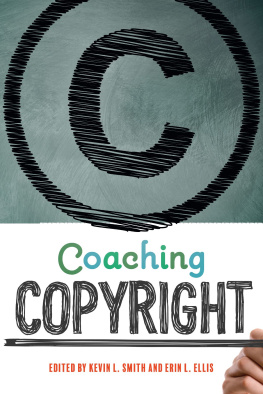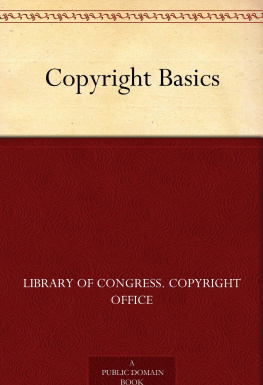
ALA Editions purchases fund advocacy, awareness, and accreditation programs for library professionals worldwide.

2020 by the American Library Association
Extensive effort has gone into ensuring the reliability of the information in this book; however, the publisher makes no warranty, express or implied, with respect to the material contained herein.
ISBNs
978-0-8389-1848-7 (paper)
978-0-8389-1881-4 (PDF)
978-0-8389-1879-1 (ePub)
978-0-8389-1880-7 (Kindle)
Library of Congress Cataloging-in-Publication Data
Names: Smith, Kevin L. (Kevin Lindsay), 1959- editor. | Ellis, Erin L., editor.
Title: Coaching copyright / edited by Kevin L. Smith and Erin L. Ellis.
Description: Chicago : ALA Editions, 2020. | Includes bibliographical references and index.
Identifiers: LCCN 2018055616 | ISBN 9780838918487 (print : alk. paper) | ISBN 9780838918791 (epub : alk. paper) | ISBN 9780838918807 (kindle : alk. paper) | ISBN 9780838918814 (pdf : alk. paper)
Subjects: LCSH: CopyrightUnited States. | Library copyright policiesUnited States. | Library orientationUnited States. | LibrariansUnited StatesHandbooks, manuals, etc.
Classification: LCC KF2995 .C576 2019 | DDC 346.7304/82dc23
LC record available at https://lccn.loc.gov/2018055616
Cover design by Karen Sheets de Gracia.
Contents
KEVIN L. SMITH
JILL BECKER AND ERIN L. ELLIS
LAURA QUILTER
ANNE T. GILLILAND
ANA ENRIQUEZ
MERINDA KAYE HENSLEY
ANALI PERRY
STEPHANIE DAVIS-KAHL AND KAREN SCHMIDT
CARLA MYERS
WILL CROSS
When the idea of a book titled Coaching Copyright was first suggested to us, we were skeptical about the title. But as we thought about it, we realized that coaching, whether one thinks of athletic coaching or the use of the word in corporate or professional contexts, was very appropriate to the situation we were being asked to address. Coaching requires a very practical approach to solving problems in specific and definable situations. Copyright education, too, is best when placed within a specific context. When librarians are asked to assist with copyright questions that arise in an educational context, coaching is exactly the approach they need to take.
This book, then, is intended to provide a practical guide for the person called upon to serve as a copyright librarian, or, indeed, anyone who is confronted with copyright dilemmas. Rather than focusing on an abstract explication of copyright law, it focuses on coaching as a framework for addressing specific copyright problems and issues, and on techniques for teaching about copyright to various audiences.
The structure of the book is dictated by this approach. The first part of the book consists of two chapters that provide general overviews of the topic of copyright coaching. The first chapter examines what it means to be a copyright coach, explicates a framework that such a coach can follow when confronted with a specific issue, and lays out the legal and practical considerations, in a condensed way, that need to be considered at each step of that framework. In the second chapter, Jill Becker and Erin Ellis place the idea of coaching in general, and coaching copyright in particular, firmly in the context of library instruction, as well as in the ACRLs Framework for Information Literacy in Higher Education. They discuss coaching as a high-impact practice that positions learners in an ideal space for understanding the nuances of copyright.
The second and longer part of this book continues the emphasis on practical applications, with eight case studies written by specialists in library instruction and in copyright. Laura Quilters initial chapter is a catalog of helpful techniques for hooking your audience on copyright, and this is followed by two chapters on specific techniques that can help convey important copyright topics: Anne Gilliland describes storytelling as an effective method, and Ana Enriquez describes role-playing as a successful approach. The next four case studies address specific audiences and contexts. Merinda Kaye Hensley focuses on opportunities to work with undergraduate research journals, and Anali Perry discusses her efforts in working with instructional designers. The next two chapters demonstrate approaches to helping administrators come to terms with copyright on campus: Stephanie Davis-Kahl and Karen Schmidt write about a liberal arts college context, and Carla Myers writes about the university context. The book closes with a report by Will Cross on a research study conducted to assess the effectiveness of an LIS class on legal issues, which includes assessments of specific instructional techniques, as well as a brief glimpse of what the future of coaching about copyright and other legal issues for librarians might look like.
KEVIN L. SMITH
Coaching Copyright
Rules and Strategies for the Game
BEING A COPYRIGHT COACH
Recently, a former colleague of my wifes, a clinician at a major U.S. hospital, got in touch with me to ask a question about a diagnostic manual he had written. He was not primarily a researcher, so he was unsure about how he should deal with copyright, licensing, and publication for the manual that his hospital superiors were encouraging him to distribute. Like so many academics, he was especially concerned about attributionhe wanted to receive proper credit for his workand he was worried that less experienced practitioners might make changes detrimental to the value of his manual. He had heard of the Creative Commons (CC) licenses and thought such a license might work for him, but he needed help to understand the CC licensing scheme and figure out how to apply one to his own work.
This situation is a nice example of coaching copyright. As a professor who teaches copyright in a law school, I strive for my students to gain a complete and detailed understanding of copyright law and the issues involved, and I try to proceed in a systematic way. But my position with this clinician was quite different. He did not want a comprehensive lesson in copyright law. In fact, such a lesson would not help; it would likely confuse him and still leave him unsure about how to proceed. What my friend needed was coachinga practical path forward that would help him achieve a specific goal. Coaching is distinguished from teaching because it is focused on a particular clients need and on obtaining a desired outcome for that client.
The clinician and I began our consultation through e-mail, and I used this initial exchange to establish some basic parameters: details about the manual in question, the kind of distribution he had in mind, and what misuse(s) he was concerned with preventing. With these basic parameters established, we sat down for a more detailed discussion. I had determined that there should be three stages to our discussion.
First, we needed to be sure that my friend was, in fact, the copyright holder in this manual. We needed to discuss the possibility that it could be considered a work made for hire and therefore owned by his employer, the hospital. I began to ask some questions about the relationship of the manual to his work, and he quickly understood that work for hire was a likely conclusion. We then discussed what further information he needed to gather to make a determination about ownership; primarily, what the hospitals intellectual property (IP) policy could tell us.
Next page










